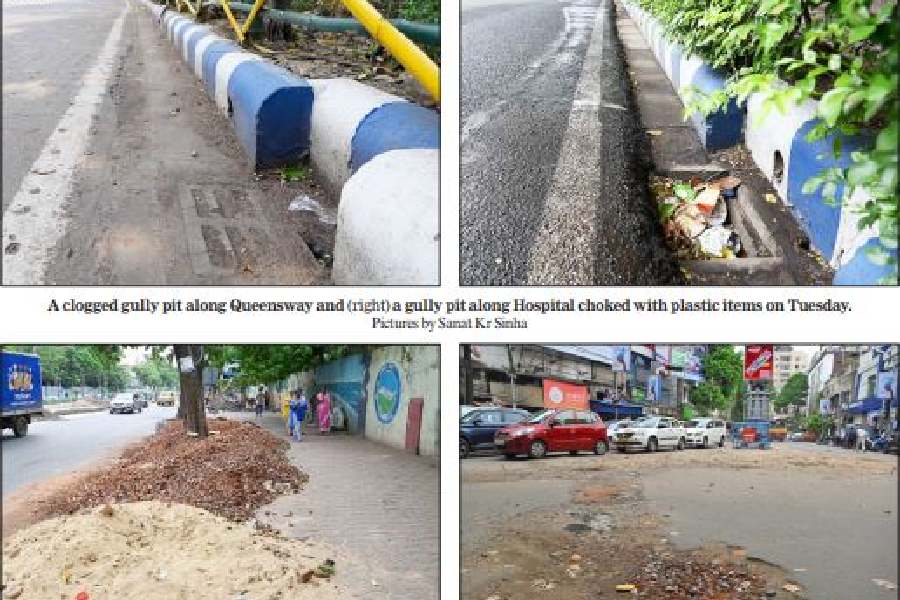The monsoon is here.
Every year, it does not take long for the initial ecstasy at the thought of the rain pulling down the mercury to make way for agony. Bad roads, waterlogged stretches, crawling traffic... monsoon peeve points are many.
The Telegraph spoke to citizens, civic engineers and urban planners to list the things that may have improved over the past year and the many that have not.
Choked gully pits
Single-use plastic, like thin plastic bags, have been banned in Bengal but they are in use everywhere. The same people who complain about waterlogging use these bags throughout the year in the name of convenience.
These are the biggest chokers of our gully pits that drain out water.
Thin plastic bags and packets of biscuits and potato wafers slip through gully pits and enter the drain. They can partially block underground drains that take rainwater into canals on the city’s outskirts.
Adding to the woes, residents allege, sewer lines are not regularly desilted and gully pits are often improperly cleaned. The gully pits, located along the edges of roads, let water flow into the gully, from where it passes into the main underground sewer lines.
KMC engineers said sewer lines are desilted and gully pits cleaned around the year. A heavy shower will tell how effective that has been.
On Tuesday, The Telegraph found choked gully pits along Queensway, in front of the Academy of Fine Arts and along Hospital Road.
Unfinished projects
Work on a drainage pumping station in Mukundapur, a waterlogging-prone pocket, is still on.
The station in Mukundapur will be ready by September, officials said. But by then the most intense phase of the monsoon will be over.
The station will drain out water from Mukundapur, Nayabad and New Garia, pockets that remain under water for days after a spell of heavy rain.
A drainage pumping station in Kidderpore, another waterlogging-prone pocket, is yet to become operational. A KMC engineer said the station is likely to start functioning by the end of June.
Construction materials
Building materials dumped along roads is a round-the-year problem. During the monsoon, it can have serious consequences. Sand, bricks and stones block the footpath forcing people to walk on the road.
“Rain makes it more difficult for motorists to see what is in front. Pedestrians, too, find it more difficult to walk in rain. If a footpath is blocked by construction materials, it increases the chances of an accident, especially when it rains,” said a resident of Nayabad.
Footpaths in Golpark and near Acropolis Mall are blocked with construction materials. Sand and broken bricks have been dumped on a part of a footpath in front of Lady Brabourne College.
Roads
In Salt Lake, roads in all three sectors have giant potholes. Major arteries such as the First Avenue and Broadway are in a sorry state and peppered with craters.
Patchwork repairs are on but they are painfully slow, say residents. “We have limited resources but are trying our best to complete work as fast as we can,” said a Bidhannagar Municipal Corporation official.
Roads in Kolkata are in poor shape, too. The crossing of Gurusaday Road and Ballygunge Circular Road is among the potholed stretches.
Canals
KMC engineers said canals have been dredged and the desilted channels are expected to drain out water faster this year. Among the desilted canals are Tollygunge-Panchannagram Canal, which drains out water from Tollygunge and Jadavpur, and Townhead Nikashi Canal and Suburban Head Canal, which drain out water from central and parts of north Kolkata.
Pumps and sluice gates
The KMC has procured over 230 portable pumps that will be placed in waterlogging-prone pockets and areas with poor drainage facilities, said an engineer of the civic body. The pumps will drain out water from these pockets to areas served by better drainage system. The pumps may also be used to discharge the water directly into underground sewer lines through manholes.
“We have 80 drainage pumping stations that together have 415 pumps. Depending on the situation, the pumps will be switched on to drain out water,” said an official.
There are seven sluice gates along the Hooghly. The gates will be manned around the clock to ensure rainwater from the city is drained into the Hooghly during low tide, an official.
